Key takeaways:
- Data quality is essential for effective decision-making, as inaccuracies can lead to significant negative outcomes and erode stakeholder trust.
- Key elements of high data quality include accuracy, consistency, completeness, timeliness, and validity, which impact not only technical processes but also human experiences.
- Maintaining high data quality enhances decision-making, builds trust within teams, and improves operational efficiency, ultimately supporting successful project outcomes.
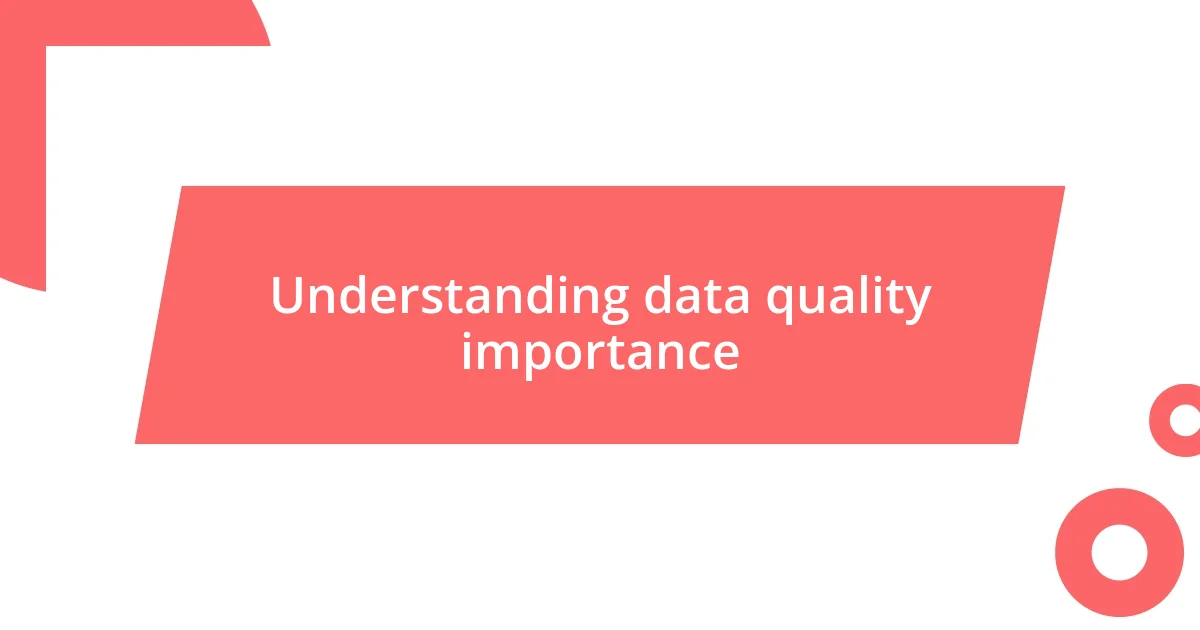
Understanding data quality importance
When I think about data quality, I can’t help but remember the times I’ve encountered poorly managed datasets. It’s like trying to navigate a ship without a compass – you often find yourself lost and confused. Have you ever wondered how many critical business decisions hinge on the accuracy of data? In my experience, even a minor error can lead to devastating outcomes, affecting not just the bottom line but also the trust of stakeholders involved.
Good data quality isn’t just a technical requirement; it’s a foundation of effective decision-making. I recall a project where we relied on outdated data to forecast sales, and the unsettling feeling of watching our projections fall flat was hard to forget. It felt as if we were chasing shadows, and in moments like those, I truly realized that accurate, timely, and relevant data fuels successful strategies and growth.
Furthermore, the emotional weight of data quality extends beyond numbers. When I helped a small business improve their data management processes, I witnessed firsthand the relief and empowerment on their team’s faces. They went from feeling overwhelmed to confident, armed with reliable insights that transformed their operations. Isn’t it incredible how something as abstract as data can profoundly impact real human experiences?
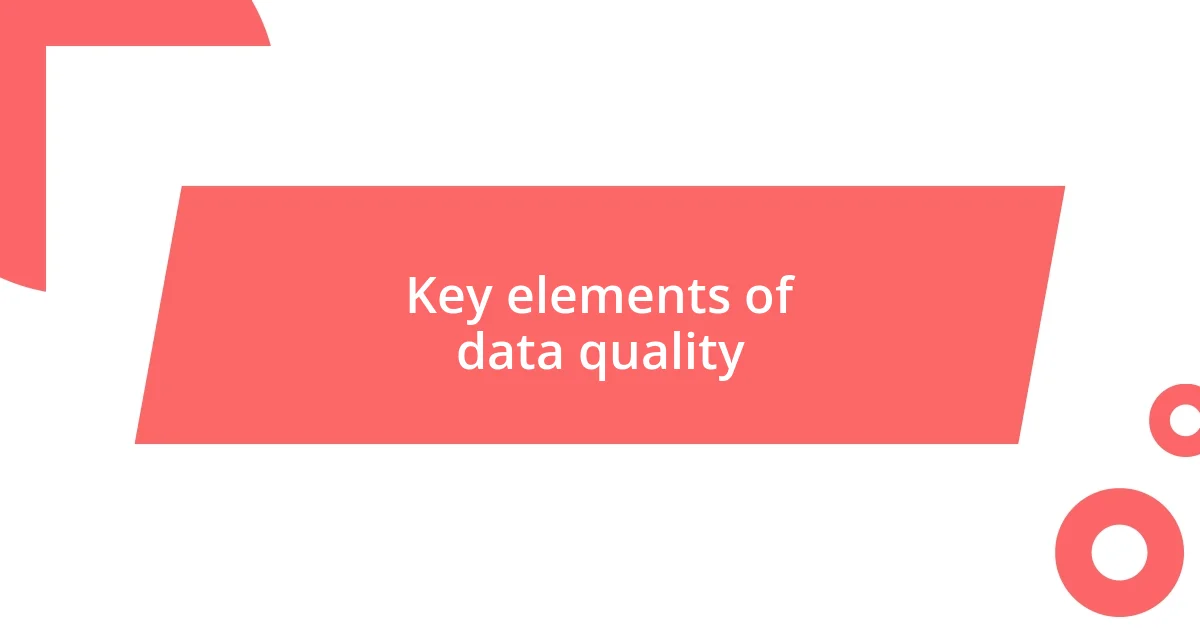
Key elements of data quality
Data quality is not just about having correct numbers; it’s about ensuring those numbers are reliable and useful. From my experience, several key elements contribute to high data quality, each influencing decision-making in unique ways. I still remember a time when I worked on a team project where inconsistencies in data formatting led to confusion about our project timelines. It underscored for me that attention to detail matters, as even the smallest inconsistencies can ripple through a project, affecting outcomes drastically.
Here are the key elements that I believe are crucial for maintaining data quality:
– Accuracy: Data must reflect the real-world situation it aims to represent.
– Consistency: Data should be uniform across different datasets and systems to avoid confusion.
– Completeness: All necessary data should be collected without gaps to form a complete picture.
– Timeliness: Information should be up-to-date, especially in fast-paced environments where conditions change rapidly.
– Validity: Data needs to conform to defined rules and constraints, ensuring it serves its intended purpose.
While these elements may seem technical at first glance, I can’t help but emphasize how they intertwine with human experiences. When I facilitated a workshop on data integrity for a non-profit organization, I witnessed how understanding these principles sparked a renewed sense of responsibility among the team. They realized that data quality wasn’t just a backend process; it directly influenced their outreach efforts and the impact they had on their community. Seeing that connection made the discussion much more relatable and driving home the importance of these elements felt gratifying.
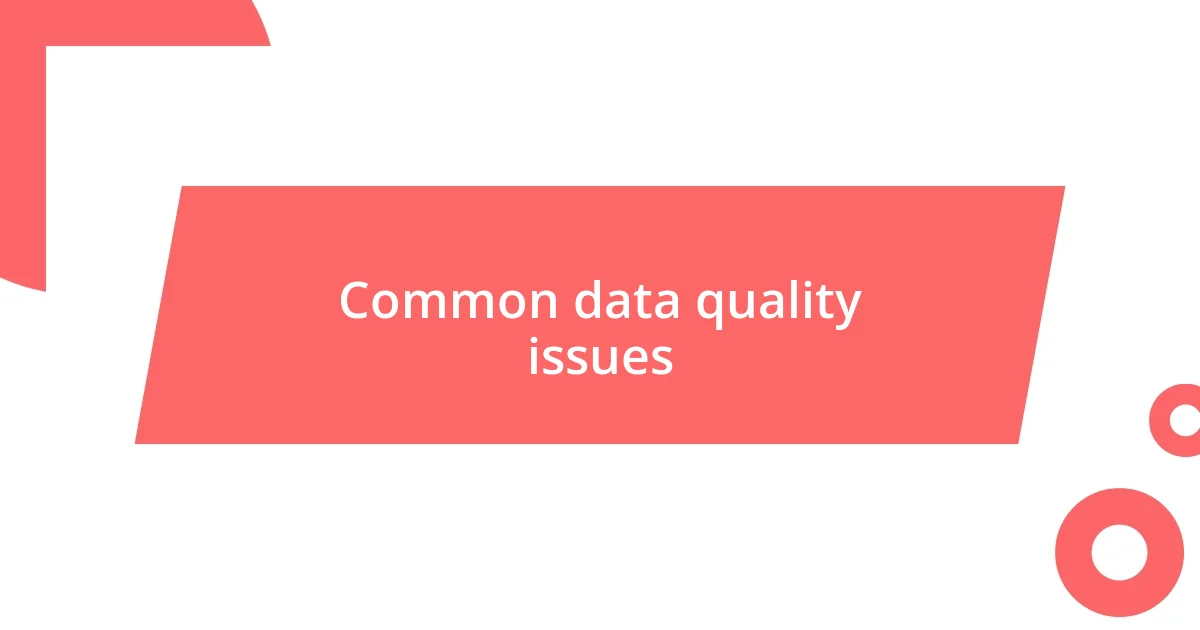
Common data quality issues
When diving into common data quality issues, one of the most prevalent challenges I’ve encountered is data duplication. It’s surprising how often the same record can appear multiple times across different datasets. I once worked with a client who realized they had multiple entries for the same customer, which not only skewed their sales metrics but also caused confusion in communication efforts. The outcome was eye-opening; cleansing that data not only improved their reports but restored their team’s confidence in the data they were using daily.
Another significant issue is missing data fields. In a project I was involved in, a crucial data entry concerning customer feedback was often left blank, leaving holes in our analysis. It was frustrating to try and piece together insights without complete information. I remember how the team felt apprehensive about making decisions based on such incomplete data; it left us second-guessing our strategies instead of confidently moving forward. This experience affirmed my belief that every data point matters, and ensuring completeness is key to high-quality data.
Finally, I’ve seen firsthand how inaccurate data can lead to poor decision-making. Once, during a major report preparation, a simple typo in a sales figure caused a ripple effect that misinformed the entire marketing strategy for the next quarter. The emotional weight of that oversight was palpable, as we realized how easily an error could cascade into larger issues. It served as a powerful reminder that accuracy isn’t just crucial—it’s fundamental to the very essence of effective decision-making.
| Data Quality Issue | Description |
|---|---|
| Data Duplication | Multiple entries for the same record causing confusion and skewed metrics. |
| Missing Data Fields | Essential information left blank, making analysis incomplete. |
| Inaccuracy | Errors in data lead to misguided decision-making and strategy misalignment. |
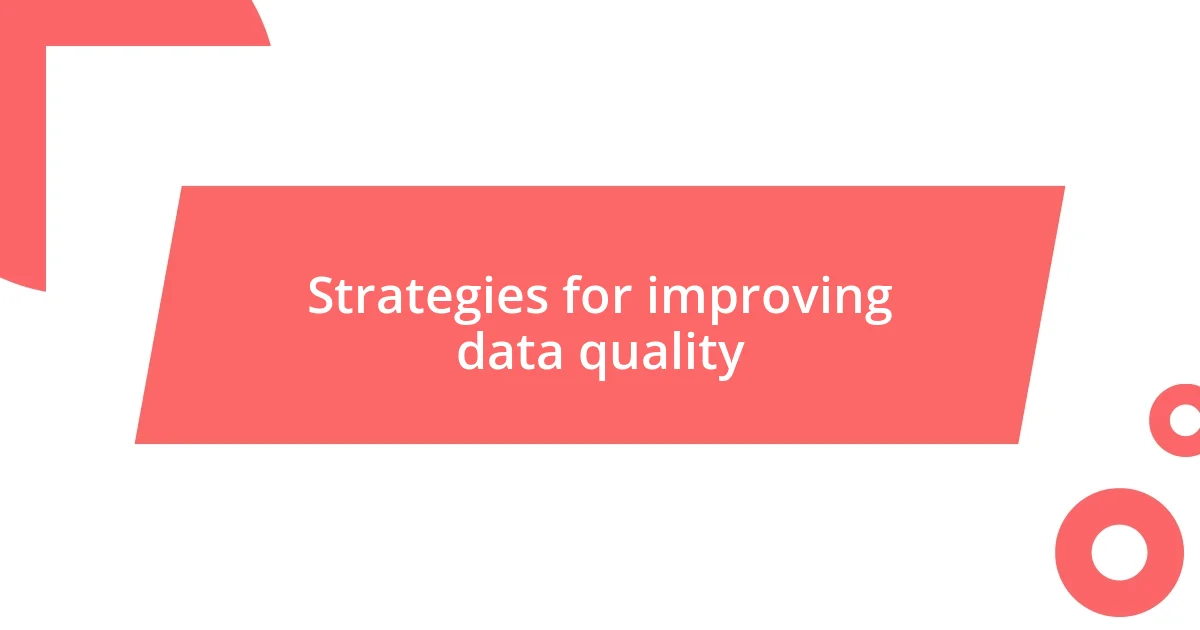
Strategies for improving data quality
Improving data quality starts with implementing regular audits. In one of my previous roles, we established a monthly review process where team members would assess our databases for accuracy and completeness. It felt like an eye-opener every time; inconsistencies would jump out that we’d previously overlooked. I often wondered, how many decisions did we make based on faulty data before this practice? It was a transformative experience, reinforcing the importance of routine checks.
Another strategy that I’ve found invaluable is fostering a data culture within the organization. When everyone understands the impact of their data contributions, it naturally leads to a collective responsibility for quality. I remember leading a team meeting where we discussed how our individual input directly affected project outcomes. The shift in perspective was palpable; it was less about pointing fingers and more about working collectively towards a common goal. Isn’t it fascinating when a team rallies around a shared purpose?
Lastly, investing in training and tools can significantly enhance data quality. In the early days of my career, I was part of a project that lacked the necessary software for data validation. This often led to manual errors that could have been easily avoided. Once we adopted specialized tools for data management, our confidence soared. Suddenly, we were able to focus on insights rather than merely correcting mistakes. Have you ever experienced that shift when the right technology empowers your team? That’s precisely what happened for us, and it reinforced the idea that the right resources can elevate our data quality to new heights.
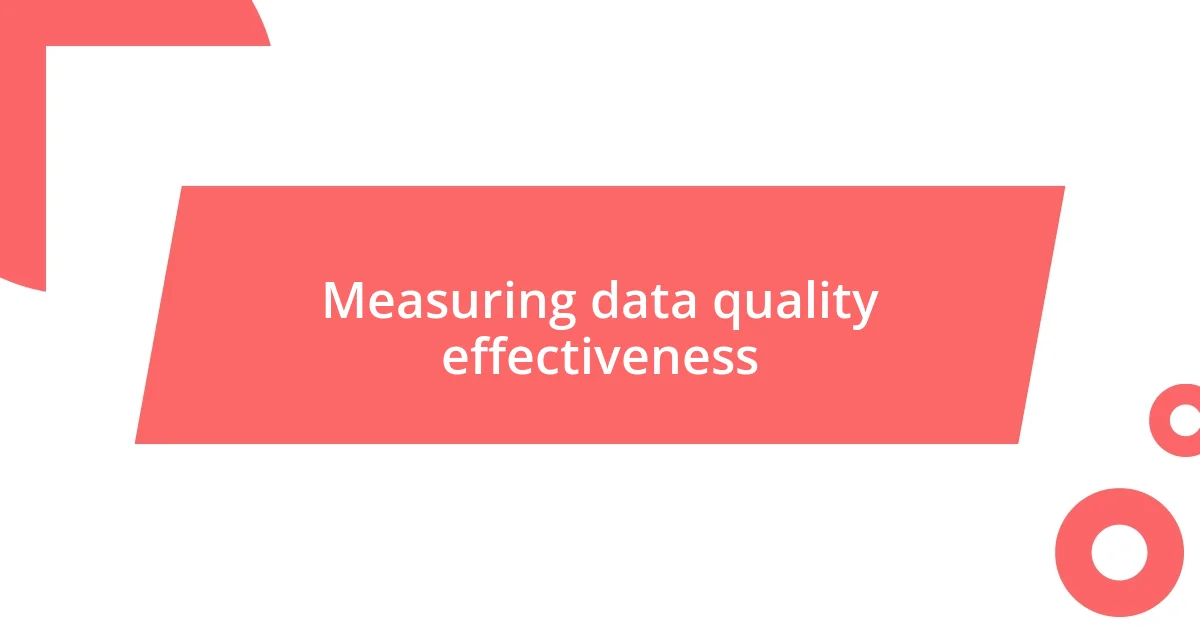
Measuring data quality effectiveness
Measuring the effectiveness of data quality can sometimes feel like navigating uncharted waters. I remember a project where we implemented key performance indicators (KPIs) specifically for data quality, such as accuracy rates and completeness scores. Tracking these metrics enabled us to see measurable improvements, but it also illuminated areas needing attention that I hadn’t initially considered. What’s fascinating is how a clear framework can transform your approach to data quality.
One effective approach I’ve found is conducting regular feedback loops. For instance, after implementing a new data entry system, we gathered input from users about what worked and what didn’t. I was astounded to hear how small changes could dramatically impact their work, such as simplifying data fields. This ongoing dialogue not only improved our system but also fostered a sense of ownership among the team. It raises a vital question: how often do we seek feedback in our data processes?
Finally, there’s the emotional side of measuring data quality. During a critical analysis presentation, I laid bare our data quality metrics, revealing that only 75% of our data was deemed high quality. I could feel the collective concern in the room; it was a wake-up call for everyone involved. By acknowledging the shortcomings, we turned that moment into a catalyst for improvement. I often wonder, isn’t it essential to be transparent about flaws if it means fostering better practices in the long run? Embracing these conversations has profoundly influenced how we prioritize data quality initiatives moving forward.
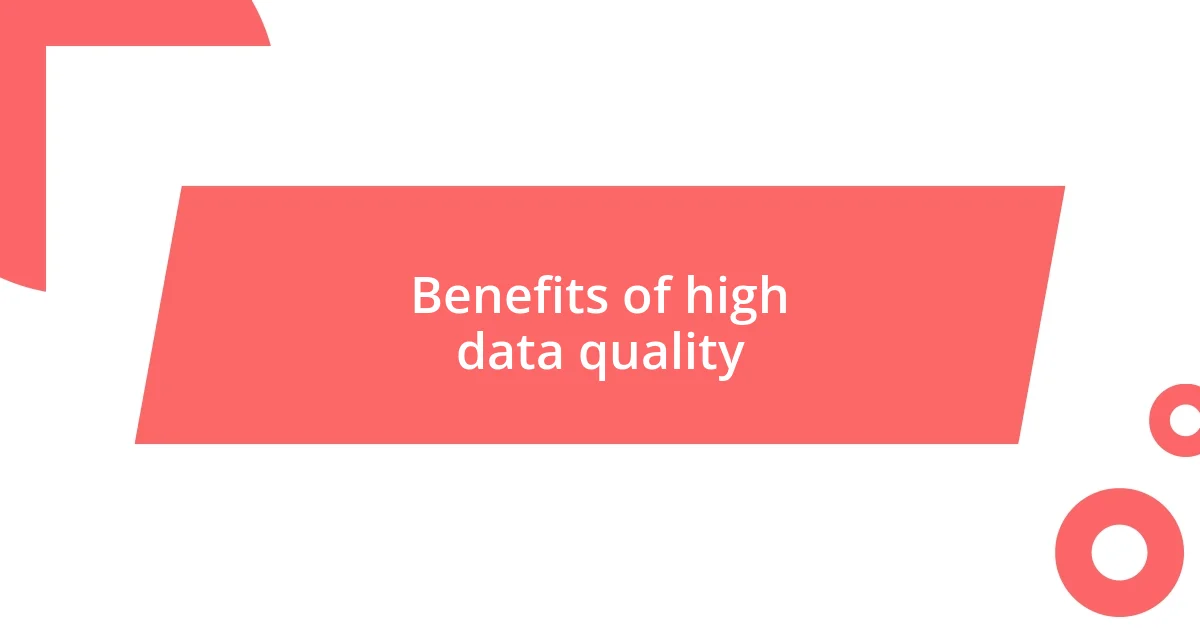
Benefits of high data quality
One significant benefit of high data quality is the enhanced decision-making it facilitates. I vividly recall a time when my team was deliberating on a major product launch. With accurate and comprehensive data at our fingertips, we pinpointed our target audience with surgical precision. It was thrilling to see how informed choices translated into successful outcomes, making me realize that data quality is truly the foundation of effective strategy. Have you ever watched a project flourish simply because the right information was utilized?
Moreover, maintaining high data quality builds trust within teams and with stakeholders. I’ve seen firsthand how consistent data integrity can instill confidence among team members. There was this pivotal moment during a quarterly review when I had to address some critical findings. Thanks to our commitment to quality, our data told a clear story. The openness and reliability of our data made it so much easier to engage in productive discussions, rather than getting sidetracked by doubts. Doesn’t it feel great when your team can rally around trusted insights?
Another vital aspect of high data quality is its impact on operational efficiency. I remember a project where misaligned data drastically slowed down our workflows. After we prioritized data quality, we noticed a significant reduction in rework and errors. Processes that once took hours now streamlined beautifully, saving time and resources. Isn’t it amazing how something as seemingly straightforward as high-quality data can unlock so much operational potential? Seeing our team work more harmoniously, focused on outcomes rather than corrections, was a profound shift I genuinely cherish.















